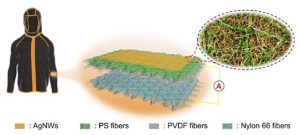
Scientists have created a new triboelectric fabric that generates electricity from the movement of the body while remaining flexible and breathable.
TW Special Report
Using the movement of a body to charge electronic devices such as phones may soon become a reality, thanks to the work done on triboelectric nanogenerators (TENGs). But most current TENGs are not breathable, making them uncomfortable to wear. Now, researchers have developed a multilayered TENG made from electrospun fibers, silver nanowires, and a polystyrene charge storage layer that not only has a high electrical performance, but also has superior wearability.
The triboelectric effect is a phenomenon where a charge is generated on two dissimilar materials when the materials are moved apart after being in contact with each other. Triboelectric nanogenerators (TENGs) use this effect to convert mechanical motion into electrical energy. The compactness of TENGs allows them to be used as wearable devices that can harness the motion of the body to power electronics. Being wearables, the emphasis is placed on the fabric properties (such as the comfort of the material) and the charge-carrying capacity of the nanogenerators. Generally, the triboelectric materials chosen for the nanogenerator should be safe, compatible with the human body (biocompatible), flexible and breathable while being able to maintain a high electrical output performance.
Among the many materials considered for TENGs, electrospun fibers are a promising candidate as they are lightweight, strong, and have desirable electrical properties. Electrospinning is a technique by which solutions of polymers are drawn into fibers using electrical charge. There are ongoing efforts to add metals to electrospun fibers to improve the electrostatic potential and charge-trapping capabilities. But this has led to compromises being made between the comfort and the output performance of the material.
In a recent study published in Nano Energy, researchers from the University of Fukui, Japan, and Nanjing University, China, have developed an all-fibrous composite layer TENG (AF-TENG) that can easily be integrated with normal cloth. “With our work, we are aiming to provide a new point of view towards wearable energy harvesters and smart textiles,” said Dr. Hiroaki Sakamoto, the corresponding author for the study.
The AF-TENG contains a triboelectric membrane made of two layers of electrospun fibers — one of a material called polyvinylidene fluoride (PVDF) and the other of a type of nylon. Silver nanowires cover these layers. The researchers further added a layer of electrospun polystyrene fibers between the silver nanowires and the triboelectric membrane.
The mechanical motion of the body while walking or running causes the triboelectric layers to gain a charge. This way, the mechanical energy is converted into electrical energy, which can be used to power electronic devices.
Normally, the charge buildup on the triboelectric surface is gradually lost or dissipated, reducing the surface charge density and the output performance of the nanogenerator. However, in this case, the added polystyrene membrane collects and traps the charge, retaining the surface charge density of the AF-TENG. The researchers used the AF-TENG to light up 126 commercial LEDs each rated at 0.06 Watt, demonstrating the feasibility of the nanogenerator. Moreover, according to Dr. Sakamoto, “The power generation device has flexibility and breathability since all components are composed of fiber materials. This device shows great potential in harvesting the static electricity from our clothes.”
While TENGs are currently limited to power low-powered devices such as LEDs and calculators, improvements to the wearability and output performance are integral steps towards future wearable technology.
Reference:
Title of original paper: An all-fibrous triboelectric nanogenerator with enhanced outputs depended on the polystyrene charge storage layer
Journal: Nano Energy
DOI: https://doi.org/10.1016/j.nanoen.2021.106515
November 2021




